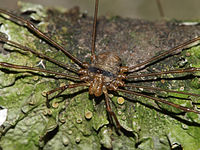
A change in the bacterial community of spider mites decreases fecundity on multiple host plants
Sign Up to like & getrecommendations! Published in 2019 at "MicrobiologyOpen"
DOI: 10.1002/mbo3.743
Abstract: Bacterial symbionts may influence the fitness of their herbivore hosts, but such effects have been poorly studied across most invertebrate groups. The spider mite, Tetranychus truncatus, is a polyphagous agricultural pest harboring various bacterial symbionts… read more here.
Keywords: community; spider mites; fecundity; host plants ... See more keywords

Selenium mediated host plant-mite conflict: defense and adaptation.
Sign Up to like & getrecommendations! Published in 2021 at "Pest management science"
DOI: 10.1002/ps.6337
Abstract: BACKGROUND Selenium has shown effectiveness in protecting plants from herbivores. However, some insects have evolved adaptability to selenium. RESULTS Selenium accumulation in host plants protected them against spider mite feeding. Selenium showed toxic effects on… read more here.
Keywords: selenium mediated; spider mites; selenium metabolism; host ... See more keywords

Aerial application methods control spider mites on corn in Kansas, USA
Sign Up to like & getrecommendations! Published in 2019 at "Experimental and Applied Acarology"
DOI: 10.1007/s10493-019-00367-3
Abstract: The Banks grass mite, Oligonychus pratensis (Banks), and two-spotted spider mite, Tetranychus urticae Koch, are important chelicerae herbivores on irrigated corn in Kansas, USA. They cause loss of foliage, stalk breakage, kernel shrinkage and yield… read more here.
Keywords: spider; application methods; corn; spider mites ... See more keywords

Non-destructive direct polymerase chain reaction (direct PCR) greatly facilitates molecular identification of spider mites (Acari: Tetranychidae)
Sign Up to like & getrecommendations! Published in 2017 at "Applied Entomology and Zoology"
DOI: 10.1007/s13355-017-0512-1
Abstract: Spider mites (Acari: Tetranychidae) include serious agricultural pests and some species have spread globally as invasive species.. For this reason, rapid and simple identification of spider mite species is necessary for agricultural field and plant… read more here.
Keywords: spider; acari tetranychidae; identification spider; spider mites ... See more keywords

No influence on population dynamics of spider mites in cotton fields of intercropping with walnut, a poor-quality host
Sign Up to like & getrecommendations! Published in 2021 at "Crop Protection"
DOI: 10.1016/j.cropro.2021.105733
Abstract: Abstract Intercropping is a common agricultural practice used to improve crop yields and profits; however, the intercrop species and its quality as a host for the main crop's key pests can affect the pests' population… read more here.
Keywords: cotton; spider mite; population dynamics; walnut ... See more keywords

Adaptive aggregation by spider mites under predation risk
Sign Up to like & getrecommendations! Published in 2017 at "Scientific Reports"
DOI: 10.1038/s41598-017-10819-8
Abstract: Grouping together is a commonly observed anti-predator strategy. Possible anti-predator benefits of aggregation include the encounter/avoidance effect for visually hunting predators and the dilution effect, together dubbed attack abatement. Possible costs opposing the dilution effect… read more here.
Keywords: aggregation; spider; predation risk; spider mites ... See more keywords

Spider mites (Acari: Tetranychidae) of Saudi Arabia: two new species, new records and a key to all known species
Sign Up to like & getrecommendations! Published in 2018 at "Journal of Natural History"
DOI: 10.1080/00222933.2018.1434251
Abstract: ABSTRACT A total of 18 spider mite species belonging to 10 genera of the family Tetranychidae (Acari: Prostigmata) are reported from different provinces of Saudi Arabia (SA). Among these, two new species, Sonotetranychus madinahensis sp.… read more here.
Keywords: species new; two new; spider mites; new species ... See more keywords

Different responses to hypobaria between spider mites and a predatory mite
Sign Up to like & getrecommendations! Published in 2017 at "International Journal of Acarology"
DOI: 10.1080/01647954.2017.1360938
Abstract: ABSTRACT Spider mites are a quarantine pest for different agricultural products imported to Japan, which may require phytosanitary treatments. To develop an environmental-friendly physical method to control agricultural pests, with minimal harm to natural enemies,… read more here.
Keywords: californicus; responses hypobaria; spider mites; different responses ... See more keywords

Antioxidant Protection by Astaxanthin in the Citrus Red Mite (Acari: Tetranychidae)
Sign Up to like & getrecommendations! Published in 2017 at "Environmental Entomology"
DOI: 10.1093/ee/nvx121
Abstract: Abstract Solar ultraviolet-B (UVB) radiation and radiant heat have lethal effects on plant-dwelling mites, including spider mites, and their natural enemies, such as phytoseiid mites, leading them to reside on lower leaf surfaces. Panonychus spider… read more here.
Keywords: antioxidant protection; radiant heat; spider mites; uvb radiation ... See more keywords

Does Long-Term Feeding on Alternative Prey Affect the Biological Performance of Neoseiulus barkeri (Acari: Phytoseiidae) on the Target Spider Mites?
Sign Up to like & getrecommendations! Published in 2017 at "Journal of Economic Entomology"
DOI: 10.1093/jee/tox055
Abstract: Abstract The predatory mite Neoseiulus barkeri (Hughes) is a good biological control agent for many small sucking pests. We aimed to determine whether rearing long term on alternative prey versus target prey species affected the… read more here.
Keywords: alternative prey; long term; spider mites; barkeri ... See more keywords

Of mites and cyanide: Rapid spider mite adaptation to Arabidopsis defense metabolites
Sign Up to like & getrecommendations! Published in 2022 at "Plant Physiology"
DOI: 10.1093/plphys/kiac247
Abstract: To get a meal, herbivores must contend with the extensive chemical arsenal of plants, an arsenal that collectively exceeds 200,000 compounds (Pichersky and Gang, 2000). While some herbivores opt to specialize on one or a… read more here.
Keywords: spider mite; defense; spider; plant ... See more keywords